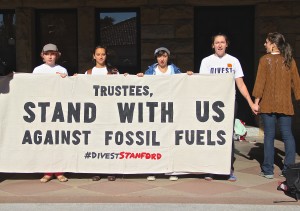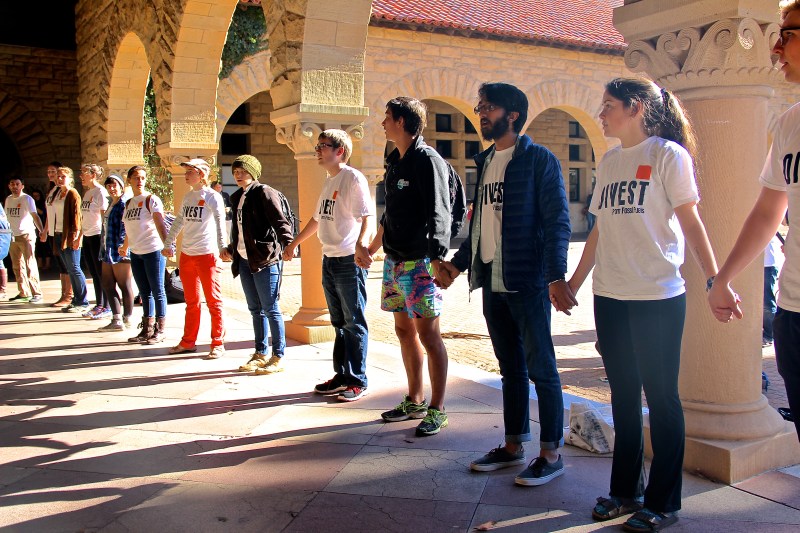
Around 1 p.m. on Monday, 104 students, many affiliated with Fossil Free Stanford, walked to Building 10, which houses the offices of the president and provost, and announced that they would be participating in a sit-in until the President John Hennessy and the Board of Trustees agreed to full divestment from fossil fuel companies. At the same time, a rally for full divestment took place in White Plaza.
At the conclusion of the main rally event, students began to put up tents around the building to camp outside the office. The participants were later issued a warning for potential violation of both the Fundamental Standard and California law.
Progress of the sit-in
When the group of around 100 students first reached Building 10, they were greeted by two police officers. Upon finding that the door was locked, Fossil Free Stanford member Michael Peñuelas ’15 M.S.’16 asked the police if they would be admitted, exercising the right of students to speak with administration.
The police officers denied the students any further entrance, and upon being asked for supervisors or administrators they could contact, the only name the officers would provide was Stanford police chief Laura Wilson.
In an email to The Daily, University spokeswoman Lisa Lapin wrote that “we respect the right of students to peacefully demonstrate in a way that does not impede University operations.”
Lapin also said that Hennessy would be willing to meet again with students if they set up an appointment through his office. Meanwhile, Hennessy was filmed around 2 p.m. getting a haircut at Stanford Hair in Tresidder Union, near the site of the rally in White Plaza. Lapin stated that Hennessy saw some students while getting his haircut but could not confirm the time.
Announcing disappointment in the Stanford administration for “refusing to even engage in the conversation,” Stanford Fossil Free logistics coordinator Yari Greaney ’15 M.S. ’16 called up letter-readers from the group of assembled students.
At the end of the letter reading, the students held hands and formed a ring encircling all of Building 10, taking off sweatshirts to reveal Fossil Free shirts. The students proceeded to join in song.
Simultaneously with this action, another group of over 200 students rallied for divestment in White Plaza to support the sit-in participants. Event emcee and Fossil Free Stanford member Emma Fisher ’17 gave a short speech highlighting the goals of the Fossil Free movement at Stanford and importance of swift action on the divestment issue and then led the gathered students in chants.
As the songs outside Building 10 continued, the group of students at the White Plaza rally marched to join the students outside the president and provost’s offices, led by Fisher and other members of Fossil Free.
After the arrival of this second group, ASSU Executives John-Lancaster Finley ’16 and Brandon Hill ’16 spoke, reminding the crowd of the “overwhelming” student support for fossil free divestment. The ASSU Undergraduate Senate, the Graduate Student Council and the student body have all voted for divestment.
[justified_image_grid ids=”1107152, 1107153, 1107154, 1107155, 1107156, 1107157, 1107158, 1107159, 1107160, 1107161, 1107162, 1107163, 1107164, 1107165, 1107166″ title_field=off caption=off]
Next, Andrea Martinez ’16 M.S.’16 spoke to the crowd. Citing the statistic that children in West Oakland are more than seven times more likely to be hospitalized with asthma than the average, she told the crowd, “I can not think of a human right more basic than breathable air.”
“We can not afford your apathy,” Martinez said as she turned toward the president’s office.
“Stanford may not be a sovereign nation, but we too are a global leader,” she added, referencing the need for action before the Paris climate negotiations in December.
Fossil Free Stanford representatives then read another letter to the larger group before announcing the beginning of the sit-in.
Potential repercussions for participants
At around 9 p.m. sit-in participants were visited and issued a warning by Nicole Taylor, associate vice provost for student affairs and dean of community engagement and diversity, and Chris Griffith, associate vice provost and dean of students. Taylor and Griffith were accompanied by a police deputy.
According to a statement read by Taylor, the students in the quad were in violation of the use of main quad and memorial court policy. This policy states that “unscheduled events and unsanctioned gatherings such as any activities with amplified sound, marches, rallies and performances” are prohibited, as is blocking the arcades in which the participants are camped out. Taylor continued that failure to comply with the policy could result in a referral to the Office of Community Standards under the Fundamental Standard.
In addition, participants were told that they could potentially be charged with a misdemeanor for trespassing or with a violation of the fire code under California law.
According to Taylor, tonight’s warning was preliminary and a formal written copy of the potential violations will be issued to participants at some time on Tuesday. She said that the purpose of this first visit was to make sure participating students were as informed as possible about policies and laws they might be violating.
Context of the sit-in
This particular civil disobedience strategy of “sit-ins” has been used at other universities with fossil fuel divestment campaigns. For example, a sit-in at Syracuse University last fall was part of a series of protests from both students and faculty that resulted in agreement by the administration to divest.
Last spring saw another wave of sit-ins at colleges such as Harvard, Swarthmore and Yale, all with mixed results. At Yale, 19 students were issued citations and fines for trespassing. At Swarthmore, the sit-in lasted 32 days before ending in a faculty vote for divestment, although the university’s board ultimately did not choose to divest.
More recently, students at MIT began a sit-in outside President L. Rafael Reif’s office on Oct. 22 after the university released a five-year plan to address climate change that did not include divestment.
The students participating in the Stanford sit-in issued a pledge in early October to engage in civil disobedience if the University did not agree to comprehensive fossil fuel divestment (as opposed to just divesting from coal companies) by the upcoming climate negotiations in Paris.
Since then, Hennessy and the Board released a letter indicating that Stanford takes climate change very seriously but did not make any further commitment to divest. While six faculty members released a response letter again urging comprehensive divestment, Fossil Free had not publicly released more details about their disobedience pledge until the start of the sit-in.
According to Fossil Free Stanford administration liaison Sijo Smith ’18, the group met in person with Hennessy, his assistant Jeff Watchel and Susan Weinstein, chair of the Advisory Panel on Investment Responsibility and Licensing (APIRL), the week before the sit-in.
“We gave three criteria for not divesting in oil and natural gas companies on principle — that fossil fuel companies commit to keeping 80 percent of their current reserves in ground, stop seeking new reserves and stop lobbying against climate policy,” Smith said.
In her email, University spokeswoman Lapin wrote, “Stanford is a leader on both sustainability and the environment and has done more to reduce its impact on climate change than any university in the country.”
Hannah Knowles contributed to this report. Photos by Raghav Mehrotra.
Editor’s note: Ada Throckmorton is an embedded reporter at the sit-in.
Contact Ada Throckmorton at adastat ‘at’ stanford.edu.
